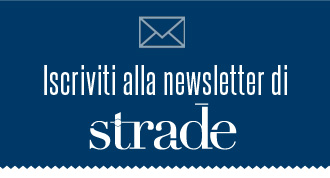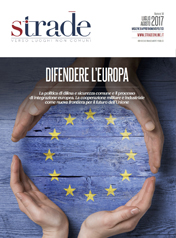A United Europe for Defence? Increased safety and lower costs
Luglio/agosto 2017 / Monografica
The European Union is moving forward at an increasingly fast pace with different visions for defence and security and it’s not working. Excessive costs and the duplication of competences that generate inefficiencies symptomatic of an approach to defence that is linked to a century-old concept: immigration and terrorism are the litmus test that highlights both limits and difficulties, all while NATO is complementary to the European project.

The only effective defence instrument for Europe at the moment is NATO, the Atlantic Alliance that, however, tends to make decisions that are not always in line with European Union interests, largely as a result of the overwhelming political weight of the United States. The America which by virtue of its leadership role, complains about the limited economic commitment of European nations that on the basis of agreements made at the 2014 Wales Summit of the North Atlantic Treaty Organization, should have brought defence spending up to 2% of national GDP, a very ambitious commitment for many European states whose economies are still struggling.
Such commitment highlights different sensibilities but also represents an opportunity to kick-start integration that can, by way of NATO efforts, facilitate the realization of a European defence system. But let’s not talk about a European army, we won’t create one if we really want to be concrete and guarantee the security of European citizens, increase the efficiency of a military instrument and avoid useless and expensive duplications.
A European army isn’t feasible due to the resistance of the 27 major military states and their Foreign Ministry counterparts who are too jealous, have too many personal ambitions, fiefdoms of unassailable power and overall, lack a strategic vision. If we can’t have a European army then it’s common defence that we need to look towards with crazy abandonment and with eyes for a radical revision that is cultural before operative and made possible thanks to a gradual process. We need more “union” in European defence.
The first objective is to create a Union Defence structure: a European military headquarters is still in the definition stage, the Military Planning Conduct and Capability Facility, that will be responsible for managing present-day European military commitments (Somalia, Mali and Central African Republic) and future ones, both executive (military operations) and non-executive (military missions).
But beyond this first objective, we are still far from the realization of a genuinely autonomous European defence reality despite the 18 May decision of European Defence Ministers to give life to the Cooperative Financial Mechanism (CFM), devoting an all-encompassing budget of 5 billion euro per year for the facilitation of progressive integration through shared activities and the rational acquisition of industrial equipment.
European defence at two speeds?
The absence of a common policy among the states of the Union with respect to defence spending and the acquisition of equipment and armaments and the reserved classification of certain countries with respect to cataloguing and the use of different items makes it difficult to conduct a comparative analysis of national commitments to a common defence.
In Central and Eastern Europe, for which data is difficult to access, we are witnessing a progressive effort to launch a modernization process of military compartments. But if Slovakia reaffirms its commitment taken at the 2014 Wales Summit of the North Atlantic Treaty Organization to bring its defence budget to 1.6% GDP by 2020, up from its current 1.11%, the Czech Republic will allocate the indispensible minimum to the development of its military capabilities as has been established in the Long Term Perspective for Defence 2030. Estonia, Hungary and Poland have also guaranteed to increase spending.
The data from Northern European countries is more transparent where as a result of Denmark’s reduction in the acquisition of materials, and therefore expenses, Norway has increased its investments and Sweden, even after having voted to contract investments in 2016, has guaranteed increased spending for 2019.
Looking at South-eastern Europe we witness a substantially static situation: Bulgaria’s efforts remain largely unchanged, at least until 2018. Croatia has reduced its efforts, and Greece is proposing progressive increases until 2020, but at the same time has made linear cuts to its defence budget.
The situation in Western Europe demonstrates that countries like Austria, France, Germany, Malta and The Netherlands are committed to increasing their defence budgets and other countries like Italy, Ireland, Portugal, Spain and Belgium instead do not foresee substantial increases or will even proceed to make cuts in the short-term (2017-2020).
In its complexity, the data available for 2015-2016 demonstrates an appreciably greater commitment on the part of a number of governments concerning the acquisition of equipment.
Within the context of a common effort, this dynamic is a key factor in the analysis of national policies in quantitative terms. In 2016 more was spent in Europe and the countries of the former Warsaw Pact initiated strategic processes with the scope of decreasing their dependence on Russia for the acquisition of military equipment. In the median period this could have positive effects on military instrument capacities. Estonia, Greece (!) and Poland are the only European countries to allocate 2% of their GDPs to defence as has been requested by NATO and the American President Donald J. Trump.
At the same time, cooperation agreements between European Union and between NATO countries are on the rise, even if the majority of these are bilateral agreements between bordering countries. “Mini-lateral” relationships that can lay the foundations of constructive collaboration but are often short-lived, have also increased. What is emerging is a European Union that is ever-more quickly travelling at two different speeds with two different approaches and visions for the Community. This is largely counterproductive to efforts for a genuine common defence.
Spend less, spend better
On a quantitative level, the EU is second only to the United States in military spending - respectively $193 billion (excluding the UK) and $611 billion. But Europe is not the second military power in the world: far from it, as it is comprised of 27 national armies united with each other through bilateral and multilateral agreements.
This represents an immense and unjustifiable cost for a non-European defence that is not limited to the economic sphere but is primarily political and strategic, with direct repercussions for the efficiency of an instrument that is fundamental for international relations and in order to reach foreign policy objectives.
This inefficiency is rooted in the substantial disorganization of the defence market and has three main causes. The first is that, despite efforts by the European Commission and the European Defence Agency (EDA), Member States opt for their national markets, causing overlaps and duplications. The second reason comes from the transfer of goods and materials for defence between Member States. The third is industrial offsetting, in other words, specific laws or directives and formal State procedures that favour relationships with national industries, permitting the survival of some industries which under normal market conditions would likely fail - it’s enough to know that 80% of military supplies for European defence are procured within national boarders. In its complexity, the result is a highly fragmented and expensive defence market teeming with multiple duplications.
Protectionism in the European defence sector is a cause for concern which is unfortunately highly underestimated. A European market for equipment would have positive effects on prices in terms of lower costs for the States. In a time of static defence budgets, continuing to acquire equipment above market price is unfeasible. Only the application of free market principles can guarantee a reduction of the duplications outlined above, more economies of scale, more industrial competition and lower prices.
Defence at a national scale ultimately leads to duplications, inefficiencies and limited overall operative capacity. A common European defence would be the exact opposite of all of this: simplification, efficiency and adequate intervention capacity to protect the foreign policy ambitions of the European Union. The numbers illustrate this concept better than any other explanation: savings, as the IAI (Istituto di Affari Internazionali) has pointed out, would range between 26 and 120 billion and would result in increased operational efficiency, services and armaments collaboration, the specialization of roles and the reduction of overlaps.
Is NATO compatible with a European defence instrument?
NATO is currently the only defence instrument for European countries as no single European state is capable of defending itself in a conventional attack or to autonomously conduct a large-scale military action for an extended period of time. NATO also has the capacity to plan, coordinate and intervene which the EU lacks. In this respect, NATO’s role is paramount. This is the situation today, but what will it be tomorrow?
While recognizing that NATO is an effective instrument for defending Western interests, and in the belief that the Atlantic Alliance is the only truly effective solution in this respect, at least two factors are worth considering. The first is the heterogeneity of organizational capabilities and of the military “timing” of single Alliance countries despite their shared standards. The second is the opportunity for the EU to have a direct role inside of NATO, replacing individual efforts which would allow for national interests and ambitions to be better balanced in favour of the Community and at the same time, to oppose strong American leadership with an equally strong EU, whose strength would be the sum of the individual national capacities. From this perspective, Europe would gain a double strategic advantage: on the one side, it would have a substantially equal relationship with the United States and on the other, it would be able to work to protect European interests by way of its own defence instrument which would be equally beneficial for NATO. In this context, US President Trump’s approach to NATO for reorientation towards the South and the East would be received positively, with significant advantages for Europe and for Italy in particular.
Spending more on NATO today is not wrong and is actually necessary in order to increase the efficiency of the European defence instrument tomorrow.
Terrorism and immigration: the answer is a shared strategy
The advantages of shared defence can be summarized in greater security for the citizens of the Union, internal stability and responsiveness to the structural phenomenon of mass immigration and terrorist threats.
Italy has everything to gain from a common undertaking which would ease its own efforts and its contribution to Frontex where it is called upon to secure the southern front. In particular, there are significant concerns for the mass immigration that will be seen in the coming years with potentially tens of millions of economic migrants making their way from Africa to the Italian coast, currently resulting in at least 500,000 illegal immigrants, the majority of whom are formally expelled but who are out of control in substance.
Italy is isolated and the EU does not want illegal immigrants. In other words, the Schengen agreement that governs the opening of internal borders requires us to close our maritime borders to economic migrants. Europe is closed and a common defence system is the only instrument capable of guaranteeing its existence. Common defence can protect our borders and at the same time can protect the migrants that in light of the growing European effort, Italy and other non-institutional actors like NGOs work to recover at sea, all while bearing witness to a continuous increase in the number of attempts to cross the Mediterranean and subsequent deaths.
In parallel to the migration phenomenon, there is a growing necessity for a common strategy to combat terrorism. The European Union Agency Frontex, in the balancing act of opening internal boarders, controls entry to external Schengen boarders by way of a series of integrated instruments, the first of which is cooperation and the exchange of information between Member States through an international database and the sharing of expertise in critical points where access is achieved thanks to criminal organizations, traffickers and terrorists.
Just think of the two cases of terrorists in some way linked to Italy who carried out recent attacks in Europe. The first is Tunisian migrant Anis Amrì, the man who carried out the December 2016 attack in Berlin. Despite Italy’s having warned German authorities, Amrì was able to attack undisturbed before returning to Italy only to be killed by Italian police in Sesto San Giovanni. The second is Italian-Moroccan Youssef Zaghba, an aspiring ISIS foreign fighter, who had previously been stopped while attempting to leave Italy (Europe) for Syria and who was later released by Italian judicial authorities due to lack of evidence and was then killed in the June 2017 jihadist attack in London.
Both subjects were present in the Schengen Information System, the international database ideated by the European Commission to increase EU security, but something didn’t work. This shows that an approach which is correct in theory can be dampened by chronic mistrust, slow action, and cultural limitations in understanding the benefits of information sharing.
The above confirms yet again that a common effort starting from defence and security is needed. Today Europe is an unexpressed power, the result of political inconsistency that impedes the definition of a common shared strategy. And the absence of this common strategy is a point of weakness that is no longer sustainable, giving rise to vulnerabilities that are ever-more pertinent in light of contemporary threats, both political-economic and strategic, and in terms of international relations and the security of the Union.
A United Europe for Defence? Increased safety and lower costs
INDICE Luglio/agosto 2017
Editoriale
Monografica
- Europa della difesa? Costa meno e ci rende più sicuri
- Investire in sicurezza: il fondo Ue per la difesa
- Common defence and security, the return of politics
- Defence as a currency, a European sovereignty
- Europe, time to unite forces
- Difesa e sicurezza comune, la rivincita della politica
- A possible EU army under current treaties
- La difesa come la moneta, una sovranità europea
- What defence for what Europe?
- Europa, è il momento di unire le forze
- Space policies, economic internationalization and EU integration
- Un esercito comune e comunitario. L’europeizzazione possibile a trattati vigenti
- A United Europe for Defence? Increased safety and lower costs
- Quale difesa per quale Europa?
- Investing in security: the European Fund for Defence
- Le politiche spaziali, l’internazionalizzazione e l’integrazione dell’Ue









